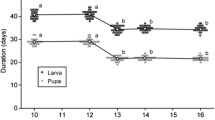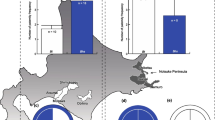Abstract
We examined sib-mated lines of the phytophagous mite, Tetranychus urticae Koch, for trade-offs in performance on different plants. We found no significant trade-offs among 10 potential host plants examined. Trade-offs in performance were not detected in most cases, even when the variations in general performance (mean performance on all potential host plants) among the sib-mated lines were statistically adjusted, denying the possibility that this may be due to the variations in general performance among the lines. No evidence for trade-offs was obtained in an artificial selection experiment; on all tested plants, a line adapted to one marginal host plant exhibited higher performance than the control line. However, the general performance seemed to be negatively correlated with other adaptive traits of the mite, such as competition ability of adult males for their mates and overcrowding response of adult females. Such correlations may contribute to the maintenance of genetic variation in the general performance of T. urticae.
Similar content being viewed by others
References
Agrawal, A.A.,Strauss, S.Y. andStout, M.J. 1999. Costs of induced responses and tolerance to herbivory in male and female fitness components of wild radish. Evolution 53: 1093–1104.
Agrawal, A.A. 2000. Host range evolution: adaptation and trade-offs in fitness of mites on alternate hosts. Ecology 81: 500–508.
Croft, B.A. andMcGroarty, D.L. 1977. The role of Amblyseius fallacis (Acarina: Phytoseiidae) in Michigan apple orchards. Res. Rep. Mich. Agr. Stn. 333: 1–22.
Fry, J.D. 1990. Trade-offs in fitness on different hosts: evidence from a selection experiment with a phytophagous mite. Am. Nat. 136: 569–580.
Fry, J.D. 1993. The ‘general vigor’ problem: can antagonistic pleiotropy be detected when genetic covariances are positive? Evolution 47: 327–333.
Gotoh, T.,Bruin, J.Sabelis, M.W. andMenken, S.B.J. 1993. Host race formation in Tetranychus urticae: Genetic differentiation, host plant preference and mate choice in a tomato and a cucumber strain. Entomol. Exp. Appl. 68: 171–178.
Gould, F. 1979. Rapid host range evolution in a population of the phytophagous mite Tetranychus urticae Koch. Evolution 33: 791–802.
Janzen, D.H. 1980. When is it coevolution? Evolution 34: 611–612.
Jeppson, L.R.,Keifer, H.H. andBaker, E.W. 1975. Mites Injurious to Economic Plants. University of California Press, Berkeley, CA, USA.
Karban, R. 1989. Fine-scale adaptation of herbivorous thrips to individual host plants. Nature 340: 60–61.
Levins, R. andMacArthur, R.H. 1969. A hypothesis to explain the incidence of monophagy. Ecology 50: 910–911.
MacKenzie, A. 1996. A trade-off for host plant utilization in the black bean aphid, Aphis fabae. Evolution 50: 155–162.
Potter, D.A.,Wrensch, D.L. andJohnston, D.E. 1976. Guarding, aggressive behavior, and mating success in male twospotted spider mites. Ann. Entomol. Soc. Amer. 69: 707–711.
Potter, D.A. andWrensch, D.L. 1978. Interrupted matings and the effectiveness of second inseminations in the twospotted spider mite. Ann. Entomol. Soc. Amer. 71: 882–885.
Service, P.M. andRose, M.R. 1985. Genetic covariation among life-history components: The effect of novel environments. Evolution 40: 492–505.
Takafuji, A. andKamibayashi, M. 1984. Life cycle of a non-diapausing population of the two-spotted spider mite, Tetranychus urticae Koch in a pear orchard. Res. Popul. Ecol. 26: 113–123.
Yano, S.,Wakabayashi, M.,Takabayashi, J. andTakafuji, A. 1998. Factors determining the host plant range of the phytophagous mite, Tetranychus urticae (Acari: Tetranychidae): a method for quantifying host plant acceptance. Exp. Appl. Acarol. 22: 595–601.
Author information
Authors and Affiliations
Rights and permissions
About this article
Cite this article
Yano, S., Takabayashi, J. & Takafuji, A. Trade-offs in performance on different plants may not restrict the host plant range of the phytophagous mite, Tetranychus urticae. Exp Appl Acarol 25, 371–381 (2001). https://doi.org/10.1023/A:1017926017081
Issue Date:
DOI: https://doi.org/10.1023/A:1017926017081




